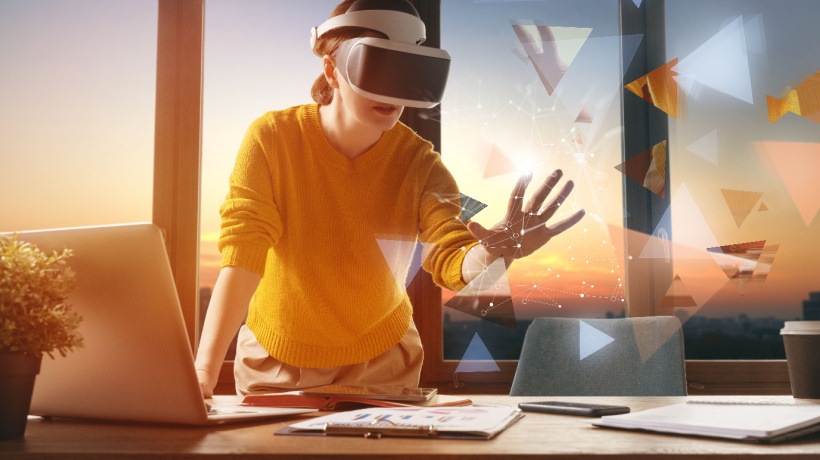Transforming L&D Environments With AR And VR
Augmented Reality (AR) and Virtual Reality (VR) are transforming Learning and Development (L&D) by offering immersive, interactive, and personalized learning experiences. These technologies provide practical applications across various industries, enhancing training programs and delivering numerous benefits.
The Practical Side Of AR And VR Technologies In L&D
Practical Applications Of AR In L&D
- On-the-job training
AR overlays digital information in the real world, providing real-time guidance and instructions. AR can guide workers through complex assembly processes in manufacturing, highlighting specific components and giving step-by-step instructions. This reduces errors and enhances productivity. - Medical training
AR allows medical professionals to visualize anatomical structures overlaid on a patient, aiding in diagnostics and surgical procedures. Medical students can practice procedures risk-free, improving their skills and confidence. - Field service training
AR provides technicians with real-time information and instructions while performing maintenance or repairs. This reduces the need for extensive manuals and improves efficiency and accuracy.
Practical Applications Of VR In L&D
- Simulated training environments
VR creates fully immersive simulations for high-risk or complex environments. In aviation, VR flight simulators provide pilots with realistic flight experiences, enabling them to practice emergency procedures and develop critical decision-making skills. In the military, VR simulates combat scenarios, helping soldiers build tactical skills and resilience. - Corporate training
VR is used for leadership development, sales training, and customer service. Employees can engage in realistic role-playing scenarios, receiving instant feedback and refining their skills in a controlled environment. - Technical training
VR enables learners to practice operating machinery, conducting technical procedures, or troubleshooting equipment in a virtual environment. This reduces the risk of injury and equipment damage while allowing hands-on practice.
Combining AR And VR: Mixed Reality For Comprehensive Training
Combining AR and VR technologies, known as Mixed Reality (MR), offers a comprehensive training approach. MR allows learners to interact with virtual and real-world elements, providing a holistic understanding of equipment operation and maintenance.
Benefits Of AR And VR In L&D
- Enhanced engagement
AR and VR create engaging and interactive learning experiences that capture learners' attention and motivate them to participate actively. - Improved retention
Immersive environments facilitate better retention of information by providing experiential learning opportunities that reinforce theoretical knowledge. - Practical skill application
AR and VR enable learners to practice skills in realistic scenarios, building competence and confidence. - Safe learning environments
These technologies allow learners to engage in high-risk or complex tasks in a safe and controlled setting, reducing the risk of injury and errors. - Personalized learning
AR and VR can be tailored to individual learning needs, providing customized experiences that address specific skills and knowledge gaps.
Implementing AR And VR In Training Programs
To effectively integrate AR and VR into training programs, follow these best practices:
1. Identify Training Needs
Determine the specific training needs and objectives that AR and VR can address. Consider tasks that require hands-on practice, complex procedures, or high-risk scenarios.
2. Choose The Right Technology
Select AR and VR solutions that align with your training objectives. Evaluate different platforms' features, scalability, and ease of use to ensure they meet your requirements.
3. Develop Quality Content
Create high-quality, interactive content that leverages the full potential of AR and VR. Collaborate with Subject Matter Experts and Instructional Designers to ensure accuracy and relevance.
4. Pilot And Evaluate
Start with pilot projects to test the effectiveness of AR and VR in your training programs. Gather feedback from learners and stakeholders to identify areas for improvement.
5. Scale And Optimize
Based on the success of pilot projects, scale up AR and VR implementation across the organization. Continuously monitor and optimize the training programs to ensure they deliver the desired outcomes.
6. Provide Training And Support
Train learners and trainers to familiarize them with AR and VR technologies. Address any technical issues and guide best practices.
Challenges And Considerations
While AR and VR offer significant benefits, there are challenges to consider:
- Cost
Implementing AR and VR can be expensive, including hardware, software, and content development costs. To justify the expenditure, evaluate the Return On Investment (ROI). - Technical requirements
Ensure your organization has the technical infrastructure, including high-performance computing and network capabilities, to support AR and VR applications. - User adoption
Encourage user adoption by providing comprehensive training and demonstrating the value of AR and VR in enhancing learning experiences. - Content quality
Developing high-quality AR and VR content requires expertise and resources. Collaborate with experienced developers and designers to create engaging and effective content. - Ethical considerations
Address ethical issues related to privacy, data security, and the potential for motion sickness or discomfort in VR environments. Implement measures to mitigate these concerns and ensure a safe and ethical learning experience.
Conclusion
Augmented Reality (AR) and Virtual Reality (VR) transform modern training programs by providing immersive, interactive, and personalized learning experiences. These technologies enhance engagement, improve retention, and enable practical skill application in a safe environment. By following best practices for implementation and addressing challenges, organizations can leverage AR and VR to create impactful and effective training programs. Embrace the potential of AR and VR to elevate your L&D initiatives and drive meaningful outcomes in an increasingly digital world.

